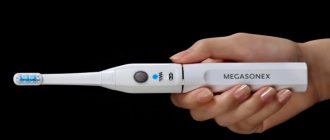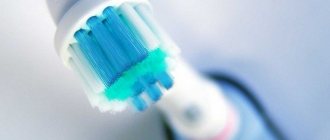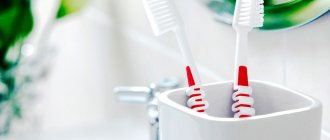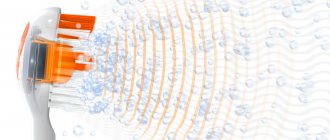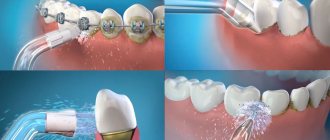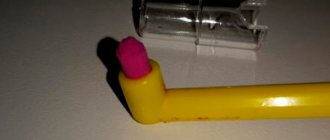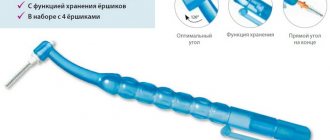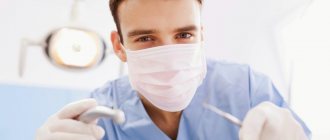We all remember the dentist’s advice from childhood: you need to change your toothbrush every three months. But when there were only ordinary toothbrushes in use, the choice of which was limited only by the size and color of the plastic handle, it was not difficult to follow this rule. Now there are many expensive models from different manufacturers on the market, which lure us with advertising, promising easy care and reliable protection against caries. Is this an innovation in the field of home hygiene or just a marketing ploy? Is it worth overpaying for new technologies or can you get by with the old-fashioned method? In this article we will tell you about all the pros and cons of an electric toothbrush, as well as how to choose one for yourself and your child in order to use it with pleasure and without harm to health.
A little bit of history
If the history of a regular toothbrush goes back more than a million years, then its electric version appeared relatively recently, in 1954, in Switzerland. Thanks to the ingenuity of Dr. Philippe Guy Voog, the world learned about the first corded toothbrush under the Broxodent brand. This device was mainly used by patients with hand motor disorders or those who corrected their bite with braces. However, already in the early 60s, General Electric introduced a cordless, battery-powered toothbrush that anyone could use. Over the next decades, perhaps, only the lazy did not conduct experiments on this device. Until 1998, about three thousand electric models were patented. The development of this indispensable device continues to this day. Innovative brushes of the latest generations can clean teeth in 10 seconds or teach children the rules of hygiene while listening to music. I wonder what miracle devices await us in the near future?
What to prefer?
There is no definite answer to this question, since everything depends on the condition of the patient’s oral cavity. For example, with healthy teeth that are prone to mineralization of plaque, you can use an ultrasonic electric brush, which is effective in preventing the formation of tartar. And if you have fillings, it is better to choose a sonic or mechanical brush. That is why the final decision to purchase a particular model is made individually, after consultation with a dentist.
Liked? Tell your friends!
Which is better - an electric toothbrush or a regular one?
A toothbrush is used to clean dental plaque, which is the main cause of caries and gum disease. According to dentists, you can effectively brush your teeth with a simple toothbrush, and even without using toothpaste. Another thing is how much effort and time you will spend on it. Electric models are designed to make hygiene as fast and comfortable as possible. Most come with a timer, and you'll quickly get into the habit of brushing your teeth for at least two minutes. Electric brushes, when used correctly, perfectly clean the surface of teeth from plaque, and ultrasound effectively removes bacteria, penetrating 6 mm into the gums. You will definitely like the effect of absolutely smooth and clean teeth.
The main difference between an electric toothbrush and a regular one is the programmed movements that must be made to properly clean your teeth.
How the device works
The electric brush consists of :
- a thick handle into which a battery is placed or removable batteries are inserted;
- housings;
- nozzle heads;
- bristles.
The battery is charged through a specialized adapter device , sold together with the electric brush; the batteries can be replaced during operation.
The rechargeable battery generates energy for a miniature motor - an inverter in the device body that converts direct current into high-frequency oscillations.
For your information! With its help, the cleaning bristles are set in motion. They vibrate automatically up and down or perform rotational and translational movements.
Types of products
The type of electrical device is determined by the method of cleaning the oral cavity and the speed of vibration of the bristles . There are models:
- Mechanical. They clean your teeth just like regular dental appliances. Their advantage is only in the greater intensity of movements and a certain direction. This guarantees high efficiency of the hygienic procedure.
- Sound. They work with bristle movements in the range from twenty-four to forty-eight thousand. The bristles rotate with great force and create a sweeping effect, removing remaining food and plaque. Such brushes operate at frequencies from two hundred to four hundred hertz and are perceived by the human hearing aid. That is, the noise from the work is easily heard by the human ear.
- Ultrasonic. The most effective and safe. Their operating frequency is not perceived by human ears. The principle of operation is the simultaneous removal of dirt and tartar with the participation of generated acoustic vibrations at a frequency of 1.6 MHz. The number of movements reaches 192 million per minute. When used for a long time, the brushes do not heat up the tissues of the oral cavity, so you can brush for a long time.
Currently, models are produced that combine sound and ultrasonic modes.
Note! When working in sound mode, food debris is removed, while in ultrasonic mode, plaque on the surface of teeth and stones are destroyed.
At the same time, the oral cavity is reliably protected from the action of bacteria.
To protect the bristles themselves from harmful microorganisms,
special docking stations are produced, where the devices are exposed to ultraviolet rays and are thereby disinfected .
This becomes most relevant when cleaning teeth without using toothpaste.
Types of Electric Toothbrushes
Currently, several types of electric toothbrushes have been developed.
- Mechanical model
The most common type, which has been on the market for decades, is a brush with a rounded head that moves from side to side. You've probably seen this device in a store. Using circular and translational movements, the brush effectively removes soft plaque from the surface of the teeth. As for the cost, for mechanical models it is the most affordable - from 2 to 5 thousand rubles. - Sound model
This toothbrush makes more than 30 thousand sound vibrations per minute - this is enough to achieve good results. The bubbles formed during brushing penetrate hard-to-reach areas and literally wash away plaque and bacteria. Sonic brushes are gentle on enamel, so they are recommended for people with sensitive teeth, as well as children. The cost of such a brush can reach 8 thousand rubles. - Ultrasonic model
According to many studies, ultrasonic models cope with plaque on teeth and gums 200% better than standard brushes. Just apply the device to your teeth for a few seconds, and under the influence of ultrasound, all soft and hard dental deposits will be destroyed. The cost of such a brush can be 10–15 thousand rubles - not everyone is mentally ready to pay that much money for such an invention, even if it is such a high-tech one.
Children's electric brushes
In order for a child to love the process of brushing teeth, it is worth purchasing a bright and cheerful model. Fortunately, manufacturers of adult devices have also taken care of the youngest consumers by offering colorful brushes with soft bristles.
Oral-B Stages Power Star Wars D12.513K
Average cost 1290 rub.
The presented model can be used by children over three years old. The device has a delicate cleaning mode, during which plaque and food debris are removed without traumatizing children's thin enamel and gums. The model has a cleaning timer to control the process. The bristles make 7600 revolutions per minute. They change color when the attachment needs to be replaced.
Oral-B Stages Power Star Wars D12.513K
Advantages
- Syncs via Bluetooth to make cleaning fun.
- There is a timer and charge indicator.
- Battery operation.
- Round shape of the nozzle.
- Ergonomic and comfortable body.
Flaws
- not found.
Philips Sonicare For Kids HX6311/07
The average cost is 2730 rubles.
The colorful design of this model attracts attention and instills in the child a desire to take care of the cleanliness of his teeth. This sonic brush has an elongated head with a frequency of 31,000 pulsations per minute.
The device runs on a battery that charges within 24 hours. The device has a system for getting used to the operation of the sound device (daily and delicate cleaning), two rotation modes, and a timer. The brush is intended for children over 7 years old.
Philips Sonicare For Kids HX6311/07
Advantages
- Autonomous operation up to three weeks.
- Comfortable ergonomic handle.
- There are 8 stickers and 2 as a gift.
- There is a storage stand.
Flaws
- Not intended for children under 7 years of age.
- Expensive replacement tips.
- Not all children welcome the sound vibrations of the brush.
At the end of the cleaning cycle (2 minutes), the device plays a melody signaling the end of the process.
Advantages of electric models
Here are the main advantages of an electric toothbrush:
- complete oral care at home
- thorough cleaning of interdental spaces (for models with ultrasonic effect)
- removal of pigmented plaque
- prevention of caries and periodontitis
- the ability to use one device for the whole family, with each member having their own attachment
- scientifically proven effectiveness compared to conventional brushes
For better oral hygiene, use additional attachments. For example, a nozzle for polishing enamel, for cleaning the tongue or interdental spaces.
Pros, benefits and benefits
It is worth noting! Electric dental cleaning products have many advantages and disadvantages compared to conventional manual teeth cleaning products:
- High-quality cleaning using an electric brush requires minimal effort and is accessible to children and people with limited mobility . You just need to bring the device to your mouth and it will clean all your teeth. Initially, this type of toothbrush was invented for use by disabled people, patients with muscle atrophy, limb fractures, and joint diseases. Later, electrical products gained popularity and began to be used everywhere in the lives of ordinary people.
- Economical to use. You can save on buying toothpaste, which has a very beneficial effect on the family budget. Instantly whipping a small amount of paste on the bristles turns it into a foam-like substance, distributing it evenly, eliminating the need to rub it in the mouth. When using ultrasonic devices, cleaning with water is allowed, and toothpaste is no longer needed. But for the effectiveness of the procedure, it is recommended to use balms, infusions, rinses that heal and disinfect the oral cavity.
- By changing different attachments, a whole family can use a single brush. Each member will choose an individual attachment, which is provided with the device. There are attachments for hard-to-reach places, for a whitening effect, for teeth with thinned enamel, for people with braces, etc.
- Time savings are provided by modern advanced models with a timer . They will warn you with a signal and stop the bristles that you need to move on to the next stage of the hygiene procedure.
- very effectively, and cases of inflammation on the gums are reduced. The pressure sensors that modern brushes are equipped with will help you avoid erasing the enamel and damaging your gums. Ultrasound, getting deep into the gum tissue, improves blood flow in them, and also has other beneficial effects for improving the health of the oral cavity.
How to choose an electric toothbrush
When choosing an electric toothbrush, focus primarily on the brand. Famous manufacturers have devoted decades to their development and clinical research in order to offer you truly high-quality and safe products today. As a rule, although Chinese copies are cheaper, they do not have a long service life or visible results. So that you do not have problems purchasing replacement nozzles, choose the most popular model, presented in many stores. There are three types of bristle hardness: soft bristles are suitable for children and people with sensitive teeth; medium bristles are suitable for those with healthy teeth; hard bristles are used only according to medical recommendations. If you often have to travel, when choosing a toothbrush, pay attention to the battery capacity: it should be maximum so that at the most inopportune moment you do not have to run and look for an outlet. For the rest, be guided by your taste and financial capabilities.
Types of cleaning devices
The classification of modern electric brushes depends on several parameters. The cleaning method divides models into the following categories:
- electromechanical , in which the villi actively move (rotate or pulsate) and efficiently clean plaque;
- sound , the work of which is based not only on vibrations, but also on sound waves;
- ultrasonic , maximally generating sound vibrations for the most inaccessible places in the oral cavity.
You may be interested in: TOP 7 best induction cookers: how to choose, reviews, characteristics, price, pros and cons
Different brush models have different power sources, which also classifies them into two types:
- battery-powered , which require frequent battery changes;
- rechargeable , charged from a 220 W network once every 5-15 days.
The movement of the bristles can be reciprocating and rotating using 1-D technology, reciprocating and sweeping using 2-D technology, and pulsating using 3-D technology.
Can children use electric toothbrushes?
Many parents are concerned about the question: can children brush their teeth with electric toothbrushes, and if so, at what age? All electric brushes, as well as regular ones, contain information about the age category, and this must be taken into account. If the child is not afraid of the buzzing sound of the brush, then starting from the age of 2–3 years, it can be used. Parents should only brush their children’s teeth, and only a few times a week, using a regular toothbrush on the rest of the days. From 6–8 years old, children can independently use children's electric models, but under the strict guidance of their mothers or fathers. A bright, functional, modern electric toothbrush will help quickly introduce your child to regular and thorough oral hygiene. At first it will be perceived as a game, but then you will see how quickly it will develop into a good habit.
The best children's toothbrush is one that is comfortable for your child to use and makes brushing their teeth a pleasure.
Cons of brushes
Important! The main disadvantage is its high cost. A high-quality, durable model that will perform all the functions of caring for teeth and the oral cavity cannot be cheap.
The average price of such a device is two thousand rubles . Models with extensive functionality cost from six thousand rubles and above.
If the size of the handle or head is not suitable, subsequent exchange of goods is not possible.
Since hygiene items cannot be returned.
Mechanical damage to which an electric brush may be subjected can permanently disable it..
Failure to comply with the operating rules written in the instructions can lead to such consequences.
The disadvantages include additional costs for replacement nozzles. They are more expensive than regular brushes. However, they need to be changed at least once every two or three months.
Keep in mind! Cash expenses will also be required to constantly recharge the batteries or purchase replacement batteries.
Tips for using electric models
- Be sure to fully charge the device before using it for the first time. This may take several hours.
- Change brush heads every three months or sooner (if bristles become deformed).
- Use the brush until it is completely discharged. It is not recommended to recharge it between procedures: this may shorten the battery life.
- Rinse the brush head thoroughly with the mode on after each use.
- To avoid toothpaste splashing, first bring the brush to your teeth and then turn it on.
- During the first days of use, you may notice slight bleeding from your gums. If this phenomenon continues for several weeks, consult your dentist.
As for the widespread opinion that electric models are unsafe for enamel, this is not entirely true. It is not the brushes that spoil the enamel, but the incorrect cleaning technique. You can damage your teeth and gums with a regular brush if you press it hard and move it chaotically. Electric models should be used carefully, without pressing: just bring the brush to the surface of the teeth, smoothly moving it from one area to another. She will do all the rest of the work for you. Before purchasing such an expensive item as an electric toothbrush for yourself and your child, be sure to consult with the specialists of the Center for Modern Dentistry. Then you will not spend your money in vain, and your new acquisition will serve you faithfully for the health of the whole family.
Comparative characteristics of models
| Name | Type | Nozzle | Number of revolutions (per minute) | Opening hours (days) | Charging time (hours) | Price, rub.) | Buyer rating |
| Oral-B Vitality 3D White Luxe | electromechanical | 1 | 7600 | 5 | 16 | 1650 | 5.0 |
| Waterpik ST-01 | ultrasonic | 2 | 40000 | 5 | 16 | 6900 | 5.0 |
| Oral-B Stages Power Star Wars D12.513K | sound | 1 | 7600 | 10 | 24 | 1290 | 5.0 |
| Philips Sonicare For Kids HX6311/07 | sound | 1 | 31000 | 21 | 24 | 2730 | 5.0 |
| Braun Oral-B Genius 9000 | electromechanical | 4 | 8000 | 14 | 16 | 8582 | 4.5 |
| Philips Sonicare CleanCare+ HX3212/03 | sound | 1 | 31000 | 10 | 16 | 2640 | 4.5 |
| Xiaomi SOOCAS X3 | sound | 1 | 37200 | 25 | 16 | 3292 | 4.5 |
| CS Medica CS-262 | sound | 1 | 33000 | 150 | AA batteries | 1100 | 4.5 |
| Braun Oral-B Trizone 500 D16 | electromechanical | 1 | 8800 | 4 | 6 | 3230 | 4.3 |
| Donfeel HSD-008 | ultrasonic | 2 | 42000 | 4 | 24 | 5400 | 4.0 |
Modern electric toothbrushes are convenient and functional. You can easily take them with you on the road. These devices protect the oral cavity from damage to tooth enamel. However, you should consult your dentist if you have certain diseases.
How to brush your teeth: instructions for using an electric appliance
Now that we have examined the principles and operating features of electric teeth cleaning devices, we can talk about how to use such devices correctly. In order for the procedure to be carried out effectively and safely, close attention should be paid to several points.
Preparation for the procedure
Before you start cleaning, wet the bristles of the tool well with water and squeeze out a small ball of paste on top. You don’t need much, otherwise too much foam will form, which will prevent you from performing the necessary manipulations properly. A pea-sized portion will be enough. Dentists recommend using the device with pastes that have an abrasiveness value of around 40-50 units. Such indicators are safe for enamel, taking into account the intensity of operation of your device.
Brush position
There are two types of placement of the device relative to the teeth: horizontal and vertical. We hold the device horizontally while treating the external and internal areas, as well as the chewing surface. The vertical position will be convenient when cleaning the front incisors. The bristles themselves, as a rule, are located at such an angle as to remove dirt from the entire surface of the tooth without scratching the enamel and gums.
Cleaning the Exterior
First, we treat the teeth from the outside. Which jaw to start with - upper or lower - is not so important. We turn on the device, bring the head to the teeth until they come into contact with the bristles. We hold the tool slightly at an angle so that the angle between the surface to be cleaned and the bristles is about 45 degrees. We work without much pressure. We linger on one tooth for a couple of seconds and move on to the other. We make sure that the villi cover each tooth from bottom to top. There is no need to perform any further manipulations - all movements are included in the program of your device.
This is interesting: Mouthwash: is it necessary and what is its benefit?
Pay special attention to the molars, because it is between them that food debris most often gets stuck, the oxidation of which contributes to the occurrence of caries.
Cleaning the interior
Having finished processing the outside, move on to the inside. There is nothing new here: gradually move along the dentition, paying attention to each area. To clean the front incisors, turn the device vertically and walk on both sides.
Completing the procedure
The total cleaning time should be two minutes. A built-in timer or an application on your smartphone will help you keep track of time. This option is available in expensive models that communicate with your mobile phone via Bluetooth and create a personal program for the user. After completing the necessary steps, rinse your mouth with clean water or mouthwash. Rinse the instrument with running water and pat dry with a towel. Wet bristles will become an environment for active growth of microbes, so do not neglect this rule.
For more information on how to use an electric toothbrush, watch the video.
